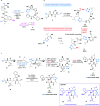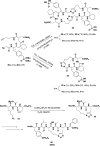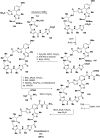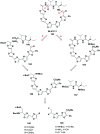Synthesis of novel cyclopeptides containing heterocyclic skeletons
- PMID: 35548835
- PMCID: PMC9086729
- DOI: 10.1039/c8ra03899f
Synthesis of novel cyclopeptides containing heterocyclic skeletons
Abstract
Cyclopeptides can be considered as naturally biologically active compounds. Over the last several decades, many attempts have been made to synthesize complex naturally occurring cyclopeptides, and great progress has been achieved to advance the field of total synthesis. Moreover, cyclopeptides containing heterocyclic skeletons have been recently developed into powerful reactions and approaches. This review aims to highlight recent advances in the synthesis of cyclopeptides containing heterocyclic skeletons such as triazole, oxazole, thiazole, and tetrazole.
This journal is © The Royal Society of Chemistry.
Conflict of interest statement
There are no conflicts to declare.
Figures





















































Similar articles
-
Diverse N-Substituted Azole-Containing Amino Acids as Building Blocks for Cyclopeptides.ACS Omega. 2020 Jan 8;5(2):1214-1220. doi: 10.1021/acsomega.9b03682. eCollection 2020 Jan 21. ACS Omega. 2020. PMID: 31984279 Free PMC article.
-
Natural Cyclopeptides as Anticancer Agents in the Last 20 Years.Int J Mol Sci. 2021 Apr 12;22(8):3973. doi: 10.3390/ijms22083973. Int J Mol Sci. 2021. PMID: 33921480 Free PMC article. Review.
-
Biological Significance of Imidazole-based Analogues in New Drug Development.Curr Drug Discov Technol. 2020;17(5):574-584. doi: 10.2174/1570163816666190320123340. Curr Drug Discov Technol. 2020. PMID: 30894111 Review.
-
Recent Advances in Synthesis and Anticancer Potential of Triazole-Containing Scaffolds.Anticancer Agents Med Chem. 2022 Aug 4;22(16):2852-2875. doi: 10.2174/1871520622666220217161346. Anticancer Agents Med Chem. 2022. PMID: 35176982
-
Recent Advances in the Synthesis of Oxazole-Based Molecules via van Leusen Oxazole Synthesis.Molecules. 2020 Mar 31;25(7):1594. doi: 10.3390/molecules25071594. Molecules. 2020. PMID: 32244317 Free PMC article. Review.
Cited by
-
Impact of the Histidine-Triazole and Tryptophan-Pyrene Exchange in the WHW Peptide: Cu(II) Binding, DNA/RNA Interactions and Bioactivity.Int J Mol Sci. 2022 Jun 23;23(13):7006. doi: 10.3390/ijms23137006. Int J Mol Sci. 2022. PMID: 35806009 Free PMC article.
-
Diverse N-Substituted Azole-Containing Amino Acids as Building Blocks for Cyclopeptides.ACS Omega. 2020 Jan 8;5(2):1214-1220. doi: 10.1021/acsomega.9b03682. eCollection 2020 Jan 21. ACS Omega. 2020. PMID: 31984279 Free PMC article.
-
Thioimidates provide general access to thioamide, amidine, and imidazolone peptide-bond isosteres.Methods Enzymol. 2024;698:27-55. doi: 10.1016/bs.mie.2024.04.012. Epub 2024 Apr 25. Methods Enzymol. 2024. PMID: 38886036 Free PMC article.
-
Trimethylaluminum-mediated one-pot peptide elongation.Chem Sci. 2023 Apr 27;14(21):5795-5801. doi: 10.1039/d3sc00208j. eCollection 2023 May 31. Chem Sci. 2023. PMID: 37265739 Free PMC article.
-
General Installation of (4H)-Imidazolone cis-Amide Bioisosteres Along the Peptide Backbone.J Am Chem Soc. 2024 May 1;146(17):11648-11656. doi: 10.1021/jacs.3c13825. Epub 2024 Apr 17. J Am Chem Soc. 2024. PMID: 38629317 Free PMC article.
References
Publication types
LinkOut - more resources
Full Text Sources

